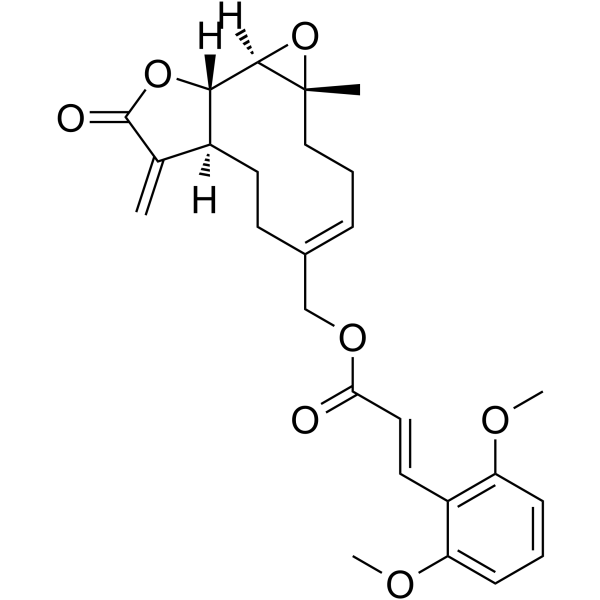anti-TNBC agent-1
Modify Date: 2024-01-03 16:50:24

anti-TNBC agent-1 structure
|
Common Name | anti-TNBC agent-1 | ||
|---|---|---|---|---|
| CAS Number | 2289585-58-4 | Molecular Weight | 454.51 | |
| Density | N/A | Boiling Point | N/A | |
| Molecular Formula | C26H30O7 | Melting Point | N/A | |
| MSDS | N/A | Flash Point | N/A | |
Use of anti-TNBC agent-1anti-TNBC agent-1 is a potent anti-triple-negative breast cancer (TNBC) agent. anti-TNBC agent-1 exhibits potent activity against different breast cancer cells with IC50 values ranging from 0.20 μM to 0.27 μM. anti-TNBC agent-1 induces apoptosis of SUM-159 cells through mitochondria pathway and causes G1 phase arrest of SUM-159 cells[1]. |
| Name | anti-TNBC agent-1 |
|---|
| Description | anti-TNBC agent-1 is a potent anti-triple-negative breast cancer (TNBC) agent. anti-TNBC agent-1 exhibits potent activity against different breast cancer cells with IC50 values ranging from 0.20 μM to 0.27 μM. anti-TNBC agent-1 induces apoptosis of SUM-159 cells through mitochondria pathway and causes G1 phase arrest of SUM-159 cells[1]. |
|---|---|
| Related Catalog | |
| In Vitro | anti-TNBC agent-1 (compound 7) exhibits potent activity against MDA-MB231, SUM-159, MCF-7, Bcap-37, 4T1 cells with IC50 values ranging from 0.20 μM to 0.27 μM. anti-TNBC agent-1 shows 11.6- to 18.6-fold improvement comparing to that of the parent compound parthenolide with IC50 values of 2.68-4.63 μM. anti-TNBC agent-1 is more active than the positive control drug Adriamycin (ADR)[1]. anti-TNBC agent-1 (2 μM and 5 μM; 48 hours; SUM-159 cells) exhibits significant stronger effect on induction of cell apoptosis compared with that of Parthenolide[1]. anti-TNBC agent-1 has selective cytotoxicity against breast cancer cells (IC50=0.22 μM) being compared with 3T3 cells (IC50=8.13 μM)[1]. |
| References |
| Molecular Formula | C26H30O7 |
|---|---|
| Molecular Weight | 454.51 |